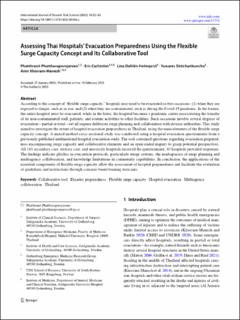| dc.contributor.author | Phattharapornjaroen, Phatthranit | |
| dc.contributor.author | Carlström, Eric | |
| dc.contributor.author | Holmqvist, Lina Dahlén | |
| dc.contributor.author | Sittichanbuncha, Yuwares | |
| dc.contributor.author | Khorram-Manesh, Amir | |
| dc.date.accessioned | 2024-03-21T10:13:00Z | |
| dc.date.available | 2024-03-21T10:13:00Z | |
| dc.date.created | 2023-03-21T13:13:49Z | |
| dc.date.issued | 2023 | |
| dc.identifier.citation | Phattharapornjaroen, P., Carlström, E., Holmqvist, L. D., Sittichanbuncha, Y., & Khorram-Manesh, A. (2023). Assessing Thai Hospitals’ Evacuation Preparedness Using the Flexible Surge Capacity Concept and Its Collaborative Tool. International Journal of Disaster Risk Science, 14(1), 52-63. | en_US |
| dc.identifier.issn | 2095-0055 | |
| dc.identifier.uri | https://hdl.handle.net/11250/3123577 | |
| dc.description.abstract | According to the concept of “flexible surge capacity,” hospitals may need to be evacuated on two occasions: (1) when they are exposed to danger, such as in war; and (2) when they are contaminated, such as during the Covid-19 pandemic. In the former, the entire hospital must be evacuated, while in the latter, the hospital becomes a pandemic center necessitating the transfer of its non-contaminated staff, patients, and routine activities to other facilities. Such occasions involve several degrees of evacuation—partial or total—yet all require deliberate surge planning and collaboration with diverse authorities. This study aimed to investigate the extent of hospital evacuation preparedness in Thailand, using the main elements of the flexible surge capacity concept. A mixed method cross-sectional study was conducted using a hospital evacuation questionnaire from a previously published multinational hospital evacuation study. The tool contained questions regarding evacuation preparedness encompassing surge capacity and collaborative elements and an open-ended inquiry to grasp potential perspectives. All 143 secondary care, tertiary care, and university hospitals received the questionnaire; 43 hospitals provided responses. The findings indicate glitches in evacuation protocols, particularly triage systems, the inadequacies of surge planning and multiagency collaboration, and knowledge limitations in community capabilities. In conclusion, the applications of the essential components of flexible surge capacity allow the assessment of hospital preparedness and facilitate the evaluation of guidelines and instructions through scenario-based training exercises. | en_US |
| dc.language.iso | eng | en_US |
| dc.rights | Navngivelse 4.0 Internasjonal | * |
| dc.rights.uri | http://creativecommons.org/licenses/by/4.0/deed.no | * |
| dc.title | Assessing Thai Hospitals’ Evacuation Preparedness Using the Flexible Surge Capacity Concept and Its Collaborative Tool | en_US |
| dc.type | Peer reviewed | en_US |
| dc.type | Journal article | en_US |
| dc.description.version | publishedVersion | en_US |
| dc.rights.holder | © The Author(s) 2023. | en_US |
| dc.source.pagenumber | 52-63 | en_US |
| dc.source.volume | 14 | en_US |
| dc.source.journal | International Journal of Disaster Risk Science | en_US |
| dc.source.issue | 1 | en_US |
| dc.identifier.doi | https://doi.org/10.1007/s13753-023-00468-z | |
| dc.identifier.cristin | 2135779 | |
| cristin.ispublished | true | |
| cristin.fulltext | original | |
| cristin.qualitycode | 1 | |

